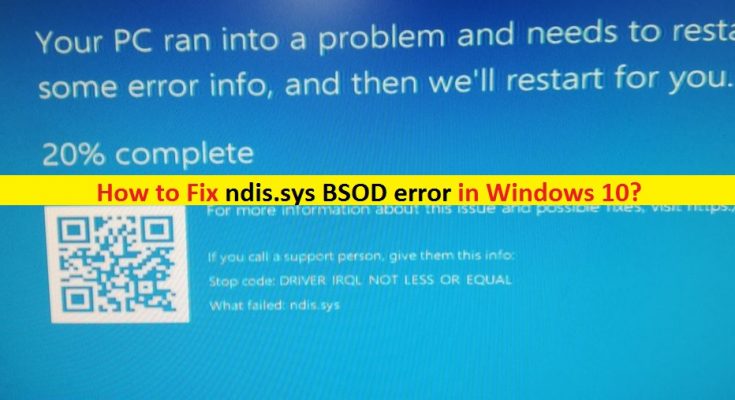What is ‘ndis.sys BSOD error’ in Windows 10?
If you are experiencing ‘ndis.sys BSOD error’ in the middle of your work on Windows 10 computer or when you start or restart your Windows 10 computer, then you are in right place for the solution. Here, you will be guided with easy steps/methods to resolve the issue. Let’s starts the discussion.
‘ndis.sys’ file: NDIS (Network Driver Interface Specification) is programming interface for NIC (Network Interface Cards). It is focused in proper functioning of system driver in computer network. This programming interface helps the computer system to interact with other hardware and devices components connected on computer network.
ndis.sys file is critical system file designed & developed by Microsoft for Windows operating system. It is important file in Windows computer and a repository of system driver settings used by Windows computer to interact with connected hardware and devices. This file is located in main drive of your computer like ‘C:\Windows\System32\drivers’.
However, several users reported that they faced ‘ndis.sys BSOD error’ when they start or reboot Windows 10 computer. This BSOD error is also occurred in the middle of their work on computer. BSOD stands for Blue Screen of Death error which interrupts your system activities by showing Blue Screen error.
This BSOD error is appeared with some message saying ‘Your PC ran into a problem and needs to restart. We’re just collecting some error info, and then we’ll restart for you’. The error screen also includes some Windows Stop Code like DRIVER_IRQL_NOT_LESS_OR_EQUAL. In sort, this BSOD error prevents you from accessing Windows desktop for some reasons.
The possible reason behind ‘DRIVER_IRQL_NOT_LESS_OR_EQUAL ndis.sys BSOD error’ can be corrupted system files or registry, misconfigured device drivers, malware or viruses attack in computer, outdated or corrupted drivers, corruption in system RAM or memory, corruption in hard disk drives or images and other reasons. Let’s go for the solution.
How to fix ndis.sys BSOD error in Windows 10?
Method 1: Fix ‘ndis.sys BSOD error’ with ‘PC Repair Tool’
‘PC Repair Tool’ is easy & quick way to find and fix BSOD errors, EXE errors, problems with programs, malware or viruses issue, system files or registry issues, and other system issues with just few clicks. You can get this tool through button/link below.
Method 2: Reinstall or update Windows 10 drivers
This BSOD error can be occurred due to corrupted or outdated Windows 10 device drivers. You can update or reinstall device drivers in order to fix the issue.
Uninstall and Reinstall Device Driver in Windows 10:
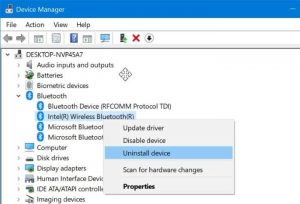
Step 1: Press ‘Windows + X’ keys on keyboard and select ‘Device Manager’
Step 2: Locate and right-click on device driver with ‘Yellow Exclamation Mark’
Step 3: Select ‘Uninstall Device’ option and follow on-screen instructions to finish uninstall. Repeat the same steps for other device drivers that causes error and after that, restart your computer
Step 4: After restart, open ‘Device Manger’ again and click on ‘Action > Scan for hardware changes’. This will reinstall your device driver. Once done, please check if the BSOD error is resolved.
Update Windows 10 drivers:

Step 1: Follow ‘step 1 and step 2’ to find the driver showing ‘Yellow Exclamation Mark’ on it
Step 2: Right-click on it and select ‘Update Driver’. Follow on-screen instructions to finish update process.
Step 3: Once done, restart your computer and check if it works.
Rollback Device Drivers:
If current driver version for the device installed in computer cause the BSOD error, then you can rollback your device driver to previous version of driver in order to fix the issue.
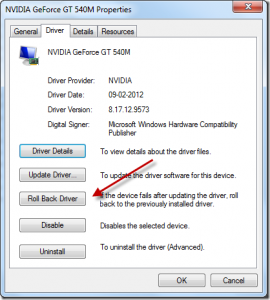
Step 1: Follow ‘step 1 and step 2’ of ‘Uninstall and reinstall device driver in Windows 10’ method to find the problematic device driver
Step 2: Right-click on it and select ‘Properties’. In ‘Properties’ window, click on ‘Driver’ tab and hit ‘Roll Back Driver’ button
Step 3: Follow on-screen instructions to finish rollback process. Once done, restart your computer and check if the error is resolved.
Download or reinstall Windows 10 drivers update [Automatically]
You can also try to update your all Windows 10 drivers to latest available build with ‘Automatic Driver Update Tool’. This software offers you to find and install all Windows drivers update with just few clicks. You can get this tool through button/link below.
Method 3: Run SFC Scan, DISM scan and CHKDSK Scan in Windows 10
You can run SFC Scan to repair system files, run DISM scan to repair hard disk/system image, and run CHKDSK scan to repair hard disk drives issue in computer in order to fix this BSOD error.
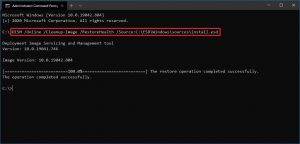
Step 1: Press ‘Windows + X’ keys on keyboard and select ‘Command Prompt as Administrator’
Step 2: Run SFC Scan. Type ‘sfc /scannow’ command and hit ‘Enter’ key to execute
Step 3: Once executed, run DISM scan. Type the following command and hit ‘Enter’ key to execute
DISM /Online /Cleanup-Image /RestoreHealth
Step 4: Once executed, run CHKDSK scan. Type ‘chkdsk /f /r’ command and then hit ‘Enter’ key to execute
Step 5: Once executed, restart your computer to see the changes and check if the BSOD error is resolved.
Method 4: Update Windows 10 OS
Updating Windows 10 OS to latest available build can resolve any issues in Windows computer and improve performances as well.
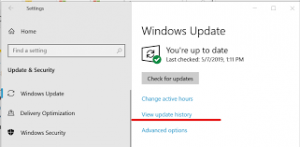
Step 1: Press ‘Windows + I’ keys on keyboard to open ‘Settings’ App in Windows 10
Step 2: In ‘Settings’ App, go to ‘Update & Security > Windows Update’ and click on ‘Check for updates’ button
Step 3: This will show you to list of available Windows updates. Click on ‘Download and Install’ to install the updates
Step 4: Once done, restart your computer to see the changes and check if the error is resolved.
Method 5: Perform System Restore operation
If the error is still persist, then you can try to fix the issue by performing System Restore operation in computer. This way, you can restore your computer to previous version according to date & time when everything was working well.
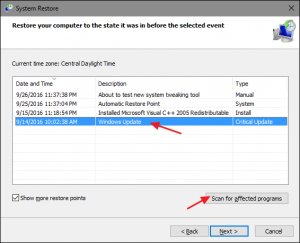
Step 1: Press ‘Windows + R’ keys on keyboard, type ‘rstrui’ in the opened ‘Run’ dialog box and hit ‘OK’ button to open ‘System Restore’ window.
Step 2: In ‘System Restore’ window, click ‘Next’, select a restore point according to date & time when everything was working well, and click ‘Next > Finish’ to start restoring process.
Step 3: Once finished, restart your computer and please check if the BSOD error is resolved.
Conclusion
I am sure this post helped you on How to fix ndis.sys BSOD error in Windows 10 with several easy steps/methods. You can read & follow our instructions to do so. That’s all. For any suggestions or queries, please write on comment box below.
